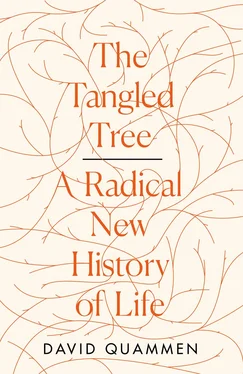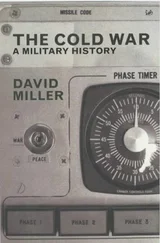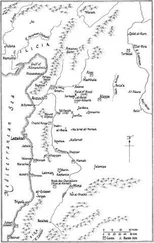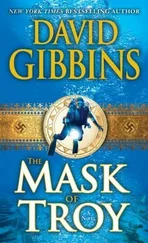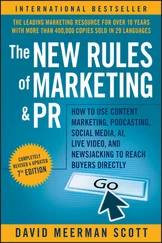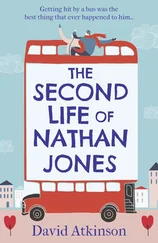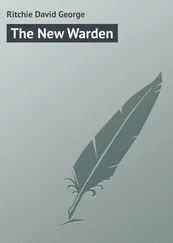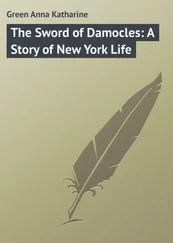He needed some such universal diagram, Woese realized, as a framework for understanding the evolution of that one crucial system at life’s core—the translation system, turning DNA-coded information into proteins. Deep biology required deep history. This conundrum has been nicely expressed by Jan Sapp, a plant geneticist who became a historian of biology and came to know Woese well: “ A universal tree would therefore hold the secretto its own existence.” History illuminating biology and vice versa. Evolutionary biology is history, after all. But there was a problem. For microbiology—bacteria and other single-celled creatures—a tree didn’t exist. The known trees didn’t encompass such organisms, or portray their diversity, to any satisfactory extent. Animals could be compared with one another on the basis of their physical appearance and behavior, as Linnaeus and Darwin had compared them; plants could be compared; fungi could be compared. They could be arranged in treelike patterns that reflected their relationships as deduced from such external, visible evidence. But that was impossible with microbes because, even under a high-powered microscope, so many of them looked so much alike.
There were a few basic shapes—rods, spheres, filaments, spirals—and those had served (reliably or not) to define major groups of bacteria. But at the finer level, the level of what we would think of as species, bacterial classification into a natural system, showing evolutionary relationships, was difficult. Arguably impossible. Even some of the experts had given up. It couldn’t be done on the basis of appearance and behavior. It couldn’t be done by way of physiological characteristics (which, in microbes, are what pass for behavior). It couldn’t be done at all, unless someone invented a new method.
“ A slight diversion in my research programwould be necessary,” Woese recollected later—a wry comment, because by then the diversion had lasted two decades.
12

On June 24, 1969, Woese in Urbana wrote a revealing letter to Francis Crick in Cambridge. He had struck up an acquaintance with Crick about eight years earlier when Woese was an obscure young biologist at the General Electric Research Laboratory in Schenectady, New York, and Crick was already world renowned for the DNA structure discovery. It had begun as a tenuous exchange of courtesies, through the mail—Woese requesting, and receiving, a reprint of one of Crick’s papers on coding—but by 1969, they were friendly enough that he could be more personal and ask a larger favor. “ Dear Francis,” he wrote, “I’m about to makewhat for me is an important and nearly irreversible decision,” adding that he would be grateful for Crick’s thoughts and his moral support.
What he hoped to do, Woese confided, was to “ unravel the course of events” leading to the originof the simplest cells—the cells that microbiologists called prokaryotes, by which they meant bacteria. Eukaryotes constituted the other big category, the other domain, and all forms of cellular life (that is, not including viruses) were classified as one or the other. Prokaryotes ( pro being the Greek for “before,” karyon the Greek for “nut” or “kernel”) are cells without nuclei. Eukaryotes ( eu for “true”) are the more complicated creatures, including multicellular animals, and plants, and fungi, plus certain single-celled but complex organisms such as amoebae, whose cells contain nuclei (hence the name, meaning “true kernel”). Prokaryotes (“before kernel”) seem to have existed on Earth before eukaryotes. Although bacteria are still around and still vastly successful, dominating many parts of the planet, they were thought in 1969 to be the closest living approximations of early life-forms. Investigating their origins, Woese told Crick, would require extending the current understanding of evolution “ backward in time by a billion years or so,” to that point when cellular life was just taking shape from … something else, something unknown and precellular.
Oh, just a billion years further back? Woese was always an ambitious thinker. “ There is a possibility, though not a certainty,” Woese told Crick, “that this can be done using the cell’s ‘internal fossil record.’” What he meant by that term was merely the evidence of long molecules, the linear sequences of units in DNA, RNA, and proteins. Comparing such sequences—variations on the same molecule, as seen in different creatures—would allow him to deduce the “ancient ancestor sequences” from which those molecules had diverged, in one lineage and another. And from such deductions, such ancestral forms, Woese hoped to glean some understanding of how creatures had evolved in the very deep past. He was talking about molecular phylogenetics, still without using that phrase, and he hoped by this technique to look back at least three billion years.
But which molecules would be the most telling? Which would represent the best internal fossil record? Frederick Sanger, a humble but visionary biochemist in England, had sequenced the amino acids of bovine insulin, and insulins are a fairly old family of molecules in animals and other eukaryotes, but they don’t go back nearly as far as Woese wanted. Other scientists had sequenced a protein called cytochrome c, also crucial in cell biochemistry among many creatures. But those didn’t satisfy Woese. He wanted something more basic, more universal—something that went all the way back, or nearly all the way, to the beginnings of life.
“ The obvious choice of molecules herelies in the components of the translation apparatus,” he told Crick. “What more ancient lineages are there?” By “translation apparatus,” Woese meant the decoding mechanism, the system that turns DNA information into proteins—the same system that Crick had groped toward understanding in his 1958 paper “On Protein Synthesis.” Investigating the translation apparatus would in turn bring Woese around toward his starting point: his desire to learn how the genetic code itself might have evolved. Now, eleven years after Crick’s protein paper, the system was much better understood.
The components Woese had in mind were pieces of a tiny molecular mechanism common to all forms of cellular life. It’s called the ribosome. Nearly every cell contains ribosomes in abundance, like flakes of pepper in a stew, and they stay busy with the task of translating genetic information into proteins. Hemoglobin, for instance, that crucial oxygen-transporting protein. Architectural instructions for building hemoglobin molecules are encoded in the DNA, but where is hemoglobin actually produced? In the ribosomes. They are the core elements of what Woese called the translation apparatus.
Crick hadn’t used that phrase, “translation apparatus,” in his paper. He hadn’t even used the word ribosomes , but he touched upon them vaguely under their previous name, microsomal particles . These particles had only recently been discovered (in 1956, by a Romanian cell biologist using an electron microscope) and at first no one knew what they did. Then they became recognized as the sites where proteins are built, but a big question remained: how? Some researchers suspected that ribosomes might actually contain the recipes for proteins, extruding them as an almost autonomous process. That notion collapsed in 1960, almost with a single flash of insight, when Crick’s brilliant colleague Sydney Brenner, during a lively meeting at Cambridge University, hit upon a better idea. Matt Ridley has described the moment in his biography of Crick:
Читать дальше
